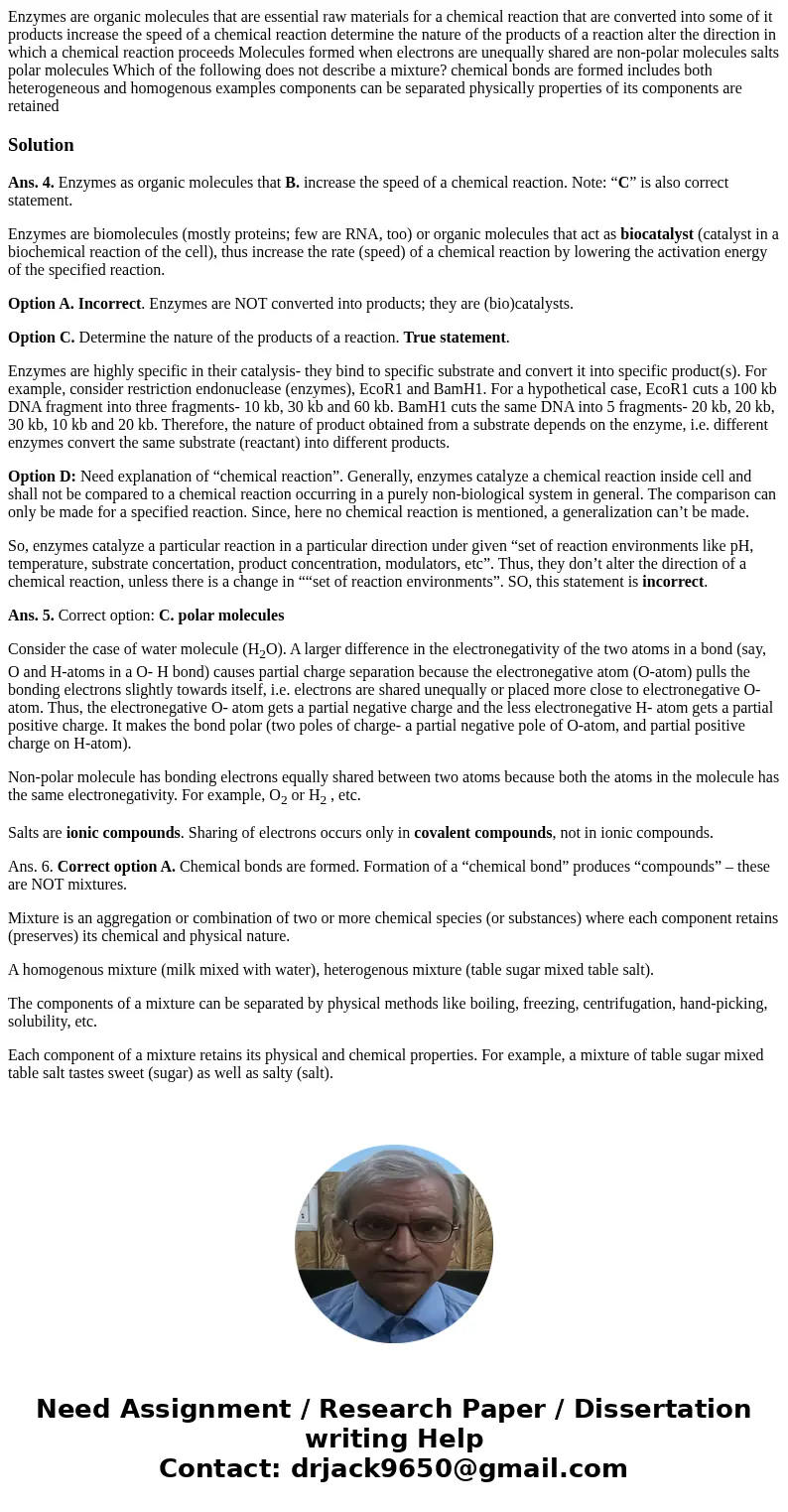Enzymes are organic molecules that are essential raw materia
Solution
Ans. 4. Enzymes as organic molecules that B. increase the speed of a chemical reaction. Note: “C” is also correct statement.
Enzymes are biomolecules (mostly proteins; few are RNA, too) or organic molecules that act as biocatalyst (catalyst in a biochemical reaction of the cell), thus increase the rate (speed) of a chemical reaction by lowering the activation energy of the specified reaction.
Option A. Incorrect. Enzymes are NOT converted into products; they are (bio)catalysts.
Option C. Determine the nature of the products of a reaction. True statement.
Enzymes are highly specific in their catalysis- they bind to specific substrate and convert it into specific product(s). For example, consider restriction endonuclease (enzymes), EcoR1 and BamH1. For a hypothetical case, EcoR1 cuts a 100 kb DNA fragment into three fragments- 10 kb, 30 kb and 60 kb. BamH1 cuts the same DNA into 5 fragments- 20 kb, 20 kb, 30 kb, 10 kb and 20 kb. Therefore, the nature of product obtained from a substrate depends on the enzyme, i.e. different enzymes convert the same substrate (reactant) into different products.
Option D: Need explanation of “chemical reaction”. Generally, enzymes catalyze a chemical reaction inside cell and shall not be compared to a chemical reaction occurring in a purely non-biological system in general. The comparison can only be made for a specified reaction. Since, here no chemical reaction is mentioned, a generalization can’t be made.
So, enzymes catalyze a particular reaction in a particular direction under given “set of reaction environments like pH, temperature, substrate concertation, product concentration, modulators, etc”. Thus, they don’t alter the direction of a chemical reaction, unless there is a change in ““set of reaction environments”. SO, this statement is incorrect.
Ans. 5. Correct option: C. polar molecules
Consider the case of water molecule (H2O). A larger difference in the electronegativity of the two atoms in a bond (say, O and H-atoms in a O- H bond) causes partial charge separation because the electronegative atom (O-atom) pulls the bonding electrons slightly towards itself, i.e. electrons are shared unequally or placed more close to electronegative O-atom. Thus, the electronegative O- atom gets a partial negative charge and the less electronegative H- atom gets a partial positive charge. It makes the bond polar (two poles of charge- a partial negative pole of O-atom, and partial positive charge on H-atom).
Non-polar molecule has bonding electrons equally shared between two atoms because both the atoms in the molecule has the same electronegativity. For example, O2 or H2 , etc.
Salts are ionic compounds. Sharing of electrons occurs only in covalent compounds, not in ionic compounds.
Ans. 6. Correct option A. Chemical bonds are formed. Formation of a “chemical bond” produces “compounds” – these are NOT mixtures.
Mixture is an aggregation or combination of two or more chemical species (or substances) where each component retains (preserves) its chemical and physical nature.
A homogenous mixture (milk mixed with water), heterogenous mixture (table sugar mixed table salt).
The components of a mixture can be separated by physical methods like boiling, freezing, centrifugation, hand-picking, solubility, etc.
Each component of a mixture retains its physical and chemical properties. For example, a mixture of table sugar mixed table salt tastes sweet (sugar) as well as salty (salt).

 Homework Sourse
Homework Sourse